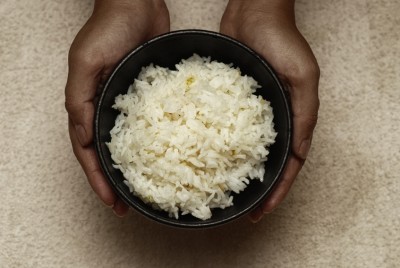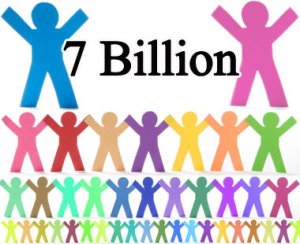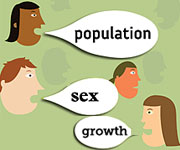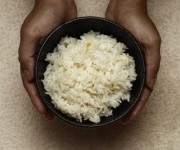 Cross-posted from Cool Green Science.
Cross-posted from Cool Green Science.
Recent global population growth estimates (10 billion by 2100, anyone?) plus slowing annual increases in agricultural yields have a lot of analysts worried that many of those new people will suffer from chronic hunger — and that much of the land that hasn’t been converted to agriculture will be plowed under to grow crops.
But a new study in the journal Nature argues that we can feed the world’s growing population without destroying the planet … if we make major adjustments now in agricultural and consumption practices and patterns. (Hey, if it were easy, we’d already be there, right?)
Based on new data about the Earth’s agricultural lands and crop yields, the study offers some core strategies to meet future food production needs and environmental challenges. Those strategies include:
- Stop farming in places like tropical rainforests, which have high ecological value and low food output;
- Improve crop yields in regions of Africa, Latin America, and Eastern Europe where farmland isn’t meeting its potential;
- Change farming practices to better manage water, nutrients, and chemicals;
- Shift diets away from meat; and
- Stop wasting food (up to one-third of all food grown is wasted either in production, transport, or after purchase).
Taken together, these strategies could lead to 100 to 180 percent more food available for consumption, and sustain the lakes, rivers, forests, and soil that food production depends on.
I talked with Jonathan Foley — lead author of the study and director of the University of Minnesota’s Institute on the Environment, as well as a member of The Nature Conservancy’s Science Council advisory board — to find out what it would take to make these recommendations a reality.
Your study’s findings are very promising. But the money question is, how do we do this? Roughly 1 billion people don’t have enough food right now, so it’s clearly a difficult challenge.
A. In this paper we’re looking at, “What does the science say?” A lot of people talk about the issue of food, but don’t have much data or science to back up the claims. So we wanted to find out which ideas can actually solve the problem.
We found that there is no silver bullet — we need to incorporate the best of what we know now into solving the world’s food problems and protecting our natural resources.
Can we do it? We have to — it’s absolutely necessary. It’s up to us to decide what’s politically feasible. We can change how we govern, tax, ship, produce, etc. What we can’t change are the laws of physics.
The problem of feeding the world and not wrecking the planet is a huge challenge and it’s going to shape a lot of the 21st century. Solving it will require huge cooperation, innovation, and hard work. What our study does is lay out the data.
Q. One focus of the article is how much land is given over to meat and dairy production, especially for growing fodder crops for these animals. Are you recommending that everyone should be vegetarian?
A. No, we’re not saying that — and that’s not realistic. People are going to eat meat. But it matters how meat is produced.
Thirty-five percent of our agricultural lands go to producing animal feed, and cattle and dairy farming take up 3.38 billion hectares. Grain-fed beef is a huge drain on the planet — it takes 30 kilos [66 pounds of grain] to produce one kilo [two pounds] of boneless beef. It’s just not efficient. We’re better off producing grass-fed beef or more chicken and pork, which requires far less grain feed. And we’re clearing rainforests to produce this meat! It’s not necessary.
Q. Speaking of rainforests — agriculture in tropical areas is increasing rapidly, yet your study says we could stop this growth altogether with little to no loss in food production. Can you explain that?
A. We found that agriculture in tropical areas yields limited food calories — most of it is going to crops like sugarcane, palm oil, and soybeans for animal feed or biofuel. Ceasing agricultural expansion into the tropics would have an impact on global food crops, but it would be small and we could offset those losses elsewhere.
It’s about the trade-offs. We lose rainforests, with huge impacts to climate change, but we don’t feed many people. Instead, we’re better off improving production in places where we currently farm than clearing more rainforests.
Q. Improving crop production and yields aren’t new ideas — what makes your approach different?
A. Yes, these things are already happening. But our study looks at it from a new perspective. Instead of trying to get high-performing farmlands to perform even better, we found that improving the lower-performing farmlands could dramatically increase the amount of food produced.
For instance, if we close the “yield gaps” in underperforming regions of Latin America, Africa, and Eastern Europe, food production could be increased by 60 percent. Closing “yield gaps” means helping poor farming regions meet their potential with basic improvements, like better use of crop varieties, irrigation, and fertilizer. Giving them access to these things, and helping them manage their land better.
Our idea is to focus on lifting the people near the bottom of the floor up closer to the ceiling, rather than lifting the ceiling higher. We need to change our approach to agriculture. Instead of sitting back and waiting for famine to strike, let’s ask: How can we prevent the next big famine?

Read more on population. Check out our series 7 Billion: What to expect when you're expanding
Q. What about organic farming — does it have a role to play in solving the global food problem?
A. Organics make up less than 1 percent of the world’s food supply right now. So, organic broccoli is not going to solve the problem of feeding the world and saving the planet’s natural resources.
But our current farming practices use a lot of water and chemicals. We need to ask, how can we improve that? Our research found that nearly half the fertilizer applied runs off rather than nourishes crops — and some places, like China and the central United States, could substantially reduce fertilizer use with little to no impact on food production.
Ultimately, it’s not abo
ut either organic or conventional; it’s about using the best from all our options. Organic farming practices blended with conventional ones — when brought to large scales — could have big impacts.
That goes for local food, too. What’s appealing about local food is that it’s grown in a competent manner, with more transparency — you know who grew it and where. Same with organic; it includes more scrutiny. But local food isn’t necessarily better for the planet on an environmental level, and it’s not practical for all the various food products we use.
The question is, could we take that same degree of competency and put it to work on the global food system? Let’s take the best from organic, local, and conventional farming practices and global trade and use all these tools.
Q. What’s an ecologist like you doing looking at agriculture and food security issues anyway?
A. Agriculture is the biggest thing we do to the planet — it covers 38 percent of the planet’s land surface — and it’s the biggest thing we do for humanity. So it makes sense for ecologists to be looking at these issues.
I’m a climatologist as well, and I was originally looking at climate change issues in my research but noticed how agriculture has such a big impact on water, climate, and land use. And the role of agriculture was not being looked at enough — remarkably very little science has been done to figure out the role of agriculture in climate change. And vice versa. Our understanding of the role that climate change plays on agriculture is still in the early stages. No doubt it will have an effect on crops — some people focus on temperature change, some focus on water. Personally, I think water will be the bigger issue.
It’s a big, messy, complicated problem.
Q. Now that the study is out, what kinds of reactions are you hoping for?
A. So far the reception to our research has been mostly positive, because we’re laying the facts out on the table and saying, “This is the science,” rather than pointing fingers or advocating for certain changes.
I hope we’ll see more collaboration — we need everyone to work together on this problem, from Big Ag companies to organic farmers. It’s time to have a sensible, grown-up conversation about these issues.
The good news is: We can feed the world and not wreck the planet.
The bad news: It’s going to take a lot of work, and right now we’re not headed in the right direction. There’s no room for error, because the pressures on our natural system are tremendous.
Read more about Jonathan Foley at the New Security Beat blog.




